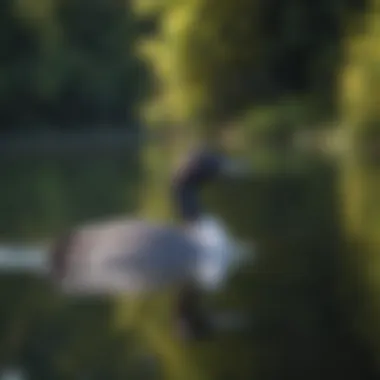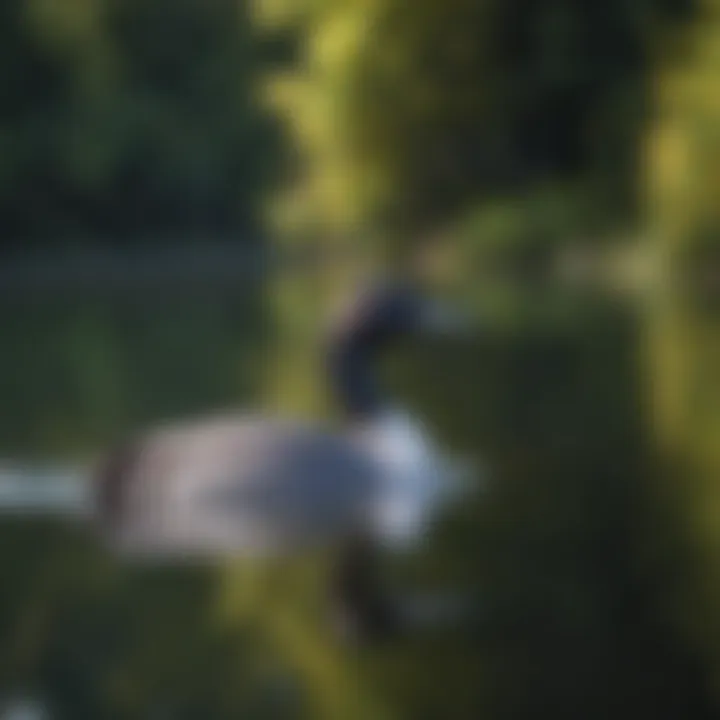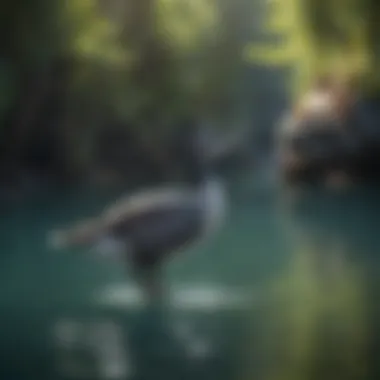Unveiling the Enigmatic World of the Loon: Characteristics, Habitat, Behavior & Conservation


Overview of the Topic
The graceful loon, with its sleek black and white plumage and piercing red eyes, is a captivating figure of the North American lakes 🌊. Its haunting calls echoing through the stillness of the water hold a sense of mystery and beauty that has intrigued nature enthusiasts for centuries. The symbolic significance of the loon transcends its physical presence, embodying a delicate balance between elegance and enigma in the aquatic world. By delving into the world of these enigmatic birds, we gain insight into a plethora of natural wonders waiting to be unveiled 🦢.
Current Status and Challenges
In the contemporary context, the loon faces numerous challenges that threaten its existence and habitat. Pollution of freshwater bodies, habitat loss due to human encroachment, and the impact of climate change on its migratory patterns are pressing issues facing the loon population today. The delicate balance of the ecosystem that supports these majestic birds is under threat, highlighting the urgency of conservation efforts to ensure their survival in the face of modern-day challenges.
Sustainable Solutions
Faced with the escalating threats to loon populations, the implementation of sustainable practices and conservation strategies is imperative. Initiatives like habitat restoration, pollution control measures, and public awareness campaigns play a crucial role in preserving the natural habitats of loons. By adopting a proactive approach to conservation, stakeholders can work together to secure a sustainable future for these magnificent birds and the ecosystems they inhabit.
Impact and Importance
The impact of loons extends far beyond their physical presence in their habitats. As indicator species, loons serve as barometers of environmental health, reflecting the well-being of the ecosystems they inhabit. Their presence not only enriches the biodiversity of their surroundings but also contributes to the cultural heritage of the regions they call home. By emphasizing the importance of conservation efforts and sustainable resource management, we pave the way for a harmonious coexistence between humans and the natural world, ensuring the legacy of the loon for generations to come.
Introduction to the Loon
In this insightful article, we embark on a deep dive into the enigmatic world of the loon, a captivating aquatic bird that intrigues and mesmerizes with its unique characteristics. From its haunting calls reverberating across serene lakes to its remarkable underwater hunting techniques, the loon symbolizes a perfect blend of elegance and mystery.
The Enigmatic Bird: A Brief Overview
The physical description of the loon sets it apart as a truly remarkable species in the avian realm. With its sleek silhouette and distinctive black-and-white plumage, the loon boasts a captivating presence that underscores its appeal to bird enthusiasts and researchers alike. Its elongated body, webbed feet, and sharp, pointed beak are key features that enable the loon to thrive in its aquatic habitat, making it a subject of fascination in ornithological studies.
Physical Description
The physical description of the loon is a pivotal aspect that defines its allure and functionality within its ecosystem. Delving into the specifics of its plumage, the contrasting patterns of black and white not only enhance its visual appeal but also serve practical purposes in camouflage and thermoregulation. The sleek, streamlined body of the loon contributes to its agile swimming abilities, enabling it to chase prey and navigate the waters with precision. Moreover, the webbed feet and sharp beak are essential adaptations that facilitate its distinct hunting techniques, making the loon a formidable predator in its environment.
Taxonomic Classification
The taxonomic classification of the loon provides valuable insights into its evolutionary history and biological relationships within the avian world. Positioned within the family Gaviidae and genus Gavia, the loon is a unique representative of diving waterbirds known for their aquatic lifestyle and distinctive vocalizations. This taxonomic placement not only underscores the loon's ecological significance but also sheds light on its behavioral patterns and adaptation strategies. By examining the taxonomic classification of the loon, researchers can glean a deeper understanding of its place in the natural world and unravel the complexities of its genetic heritage.
Historical Significance


Exploring the historical significance of the loon unveils a rich tapestry of cultural depictions and symbolic interpretations that have endured through time. From ancient folklore to modern representations, the loon holds a special place in the human psyche, serving as a muse for art, literature, and spiritual beliefs.
Cultural Depictions
The cultural depictions of the loon span a diverse array of narratives and artistic expressions that celebrate its enigmatic charm. Across various cultures and traditions, the loon is often portrayed as a symbol of grace, tranquility, and mystery, capturing the imagination of both artists and audiences. Its elegant presence and haunting calls have inspired poets, painters, and storytellers to incorporate the loon into their creative works, highlighting its symbolic significance in narratives of nature and mystique.
Native American Symbolism
In Native American folklore and symbolism, the loon assumes a prominent role as a spiritual guide and totemic emblem representing wisdom, vision, and connection to the natural world. Tribes such as the Ojibwe and Cree attribute special meanings to the loon, associating it with themes of transformation, protection, and harmony. The intricate lore surrounding the loon in Native American culture serves as a testament to its enduring symbolism and enduring resonance as a revered animal spirit.
Habitat and Distribution
Exploring the habitat and distribution of the loon is imperative in unraveling its mysterious existence within the realm of avian diversity. The significance of understanding where the loon chooses to reside lies in deciphering the intricate web of ecosystems it thrives in. By delving into its habitat preferences, we gain valuable insights into the bird's survival strategies and evolutionary adaptations as they relate to the aquatic landscapes they inhabit.
Preferred Environments
Freshwater Ecosystems
Freshwater ecosystems play a pivotal role in shaping the loon's habitat choices, providing crucial resources for their sustenance and reproduction. These aquatic environments offer abundant fish populations, a staple in the loon's diet, and are characterized by the tranquility necessary for successful breeding. The shallow waters of freshwater ecosystems facilitate the loon's diving prowess, enabling swift and efficient hunting expeditions beneath the surface. While these habitats offer prime conditions for foraging and nesting, they may also be susceptible to human disturbances, posing challenges to loon conservation efforts.
Boreal Forests
Boreal forests stand as vital habitats for the loon, offering a unique juxtaposition to its aquatic lifestyle. These dense woodlands provide secluded nesting sites along undisturbed shorelines, shielding the loon and its offspring from potential predators. The pristine lakes within boreal forests serve as serene breeding grounds, where the haunting calls of the loon resonate amidst towering conifers. Despite the tranquil beauty of these forests, climate change poses a significant threat to their integrity, potentially disrupting the delicate balance that sustains loon populations.
Global Distribution
North America
North America emerges as a prominent region in the global distribution of the loon, symbolizing vast territories where these birds find sanctuary. The expansive lakes and wetlands of North America offer ample room for loons to thrive, with the Great Lakes region notably serving as a crucial stronghold for these majestic creatures. The migratory patterns of North American loons exemplify their adaptability to changing seasons, highlighting their resilience in the face of environmental challenges.
Europe and Asia
In the realms of Europe and Asia, the enigmatic presence of the loon graces select water bodies, adding a touch of ethereal mystery to these continents. The tranquil lakes of Europe mirror the bird's affinity for serene waters, while the vast expanses of Asia provide ample opportunities for breeding and foraging. As the borders between regions blur, loons traverse diverse landscapes, showcasing their remarkable ability to thrive in varied environments despite increasing human encroachment.


Behavior and Adaptations
Delving into the intricacies of the behavior and adaptations of the enigmatic loon in this article has significant importance. By understanding how loons behave and adapt to their environment, we gain valuable insights into their survival strategies and ecological role. The behavior of loons, including their feeding habits and breeding rituals, offers a window into their fascinating world of avian adaptations and strategies for thriving in diverse ecosystems.
Feeding Habits
Diet Composition
The diet composition of loons is a critical aspect of their survival and lifestyle. Their diet primarily consists of fish, crustaceans, and aquatic invertebrates, providing them with essential nutrients for energy and growth. The key characteristic of their diet composition lies in its high protein content, which fuels their active lifestyle and diving proficiency. This protein-rich diet is a strategic choice for loons as it supports their physical demands and hunting prowess in aquatic environments. Despite potential challenges in accessing certain prey species, the adaptability of their diet composition ensures a sustainable food source for loons, reflecting their specialized feeding behavior.
Foraging Techniques
Loons employ distinctive foraging techniques that enhance their efficiency in capturing prey. Their adept diving abilities allow them to plunge underwater in search of food, utilizing their streamlined bodies and webbed feet for swift propulsion. The key characteristic of loons' foraging techniques is their stealthy approach to hunting, utilizing patience and precision to ambush unsuspecting prey. This calculated method of foraging is a beneficial strategy for loons as it minimizes energy expenditure and maximizes hunting success. Despite potential drawbacks such as prolonged periods underwater, their unique foraging techniques have evolved to optimize food acquisition and ensure survival in their aquatic habitats.
Breeding Behavior
The breeding behavior of loons plays a pivotal role in their reproductive success and species persistence. By examining their nesting rituals and parental care strategies, we can uncover the intricacies of their breeding ecology and familial dynamics. The nested approach of loons towards breeding sheds light on their commitment to offspring survival and genetic lineage preservation.
Nesting Rituals
Nesting rituals are a fundamental aspect of loons' breeding behavior, delineating their mating patterns and territorial maintenance. The key characteristic of their nesting rituals lies in the selection of secluded nest sites near water bodies, providing protection from predators and environmental elements. This strategic choice enhances the chances of breeding success and chick survival, underscoring the importance of nesting rituals in the reproductive cycle of loons.
Parental Care
Parental care among loons showcases their dedication to nurturing and safeguarding their young. The key characteristic of loons' parental care is their cooperative approach to chick rearing, with both parents sharing responsibilities such as feeding and protection. This shared parental investment ensures the well-being of offspring and fosters social bonds within loon families. Despite challenges like predation and human disturbance, the unique parental care exhibited by loons contributes to the resilience of their populations and strengthens the fabric of their avian communities.
Communication and Calls
Communication and calls play a pivotal role in understanding the behavior and interactions of the elusive loon. Vocalizations serve as a distinctive feature of the loon's communication repertoire, offering insights into its social structure and territorial dynamics. By delving into the nuances of the loon's calls, researchers and enthusiasts unravel the intricate web of relationships and behaviors that define this enigmatic bird. Understanding the significance of these vocalizations enhances our appreciation for the loon's complex communication system, shedding light on its role in signaling warnings, claiming territories, and attracting potential mates.
Vocalizations
Territorial Calls


Territorial calls are a fundamental aspect of the loon's vocal repertoire, serving as a key mechanism for establishing and defending territories within its freshwater habitats. These calls, characterized by their haunting tone and prolonged echoes across tranquil lakes, act as a formidable deterrent to intruders while asserting dominance within the loon's territorial boundaries. The distinctive nature of territorial calls allows loons to maintain spatial integrity and regulate social hierarchies, ultimately contributing to the species' survival and reproductive success. Despite their eerie sound, territorial calls are a valuable tool for understanding the loon's habitat preferences and spatial utilization, making them a focal point of study in ornithological research.
Mating Calls
Mating calls play a crucial role in the loon's reproductive behavior, facilitating pair bonding and mate selection during the breeding season. These calls, characterized by their melodious quality and distinct patterns, serve as a form of courtship display, signaling readiness for breeding and reinforcing the bond between mates. The intricate nature of mating calls reflects the loon's innate reproductive instincts and evolutionary adaptations, highlighting the species' remarkable vocal communication abilities. While mating calls are essential for successful breeding, they also provide researchers with valuable insights into the loon's breeding ecology and reproductive strategies, making them a significant focus of behavioral studies.
Significance of Calls
Social Communication
Social communication plays a vital role in shaping the loon's group dynamics and cooperative behaviors, fostering communal interactions and maintaining order within loon populations. Through a diverse range of vocal signals and behaviors, loons engage in complex social exchanges, establishing alliances, resolving conflicts, and reinforcing social bonds. The power of social communication lies in its ability to strengthen intra-group relationships and promote collective cohesion, ultimately enhancing the loon's survival prospects in the face of environmental challenges. By unraveling the intricacies of social communication, researchers gain deeper insights into the social structure and behavior patterns of these enigmatic birds, enriching our understanding of their complex social lives.
Recognition
Recognition calls serve as a cornerstone of the loon's individual recognition system, allowing for the identification of partners, offspring, and familiar individuals within its social network. These distinctive calls convey unique acoustic signatures that facilitate accurate identification and differentiation among group members, enabling precise communication and coordination in various social contexts. The significance of recognition calls lies in their role in reinforcing social bonds, minimizing intergroup conflicts, and promoting cooperation among loons. Through the study of recognition calls, researchers gain valuable insights into the cognitive abilities and social dynamics of loons, unveiling the intricate mechanisms underlying their social behavior and group cohesion.
Conservation Status
The conservation status of the loon is a critical component of this article, shedding light on the pressing need to protect this captivating species. As environmental stewards, understanding the challenges faced by loons in their habitats is paramount. Conservation efforts are imperative to safeguarding the future of these birds and ensuring the balance of aquatic ecosystems they inhabit. By delving into the threats confronted by loons, we can comprehend the importance of proactive conservation measures. Through detailed insights into habitat loss, pollution, and other factors, we can grasp the significance of prioritizing conservation initiatives to secure the well-being of these mysterious birds.
Threats to Survival
Habitat Loss
In discussing habitat loss, we uncover a pivotal threat to the survival of loon populations worldwide. The degradation and destruction of their natural habitats, such as freshwater lakes and boreal forests, severely impact these avian creatures. The alteration of nesting sites and foraging grounds due to human encroachment poses a significant risk to the breeding success and overall population health of loons. Habitat loss not only disrupts their behavioral patterns but also diminishes their ability to find suitable resources vital for their survival. Understanding the detrimental effects of habitat loss on loon populations underscores the urgency of implementing conservation strategies to mitigate these adverse impacts.
Pollution
Pollution emerges as another formidable menace contributing to the deterioration of loon habitats and populations. The contamination of water bodies with plastics, chemicals, and toxins poses grave threats to the health and well-being of loons. From hindering their hunting capabilities to compromising their reproductive success, pollution exerts a detrimental influence on the overall resilience of these aquatic birds. Unraveling the complexities of pollution and its effects on loons underscores the necessity of stringent environmental regulations and community efforts to combat water pollution and preserve the pristine habitats essential for the survival of these remarkable avian species.
Conservation Efforts
Protected Areas
Examining the importance of protected areas reveals a beacon of hope for safeguarding loon populations and their habitats. Designating specific regions as protected areas offers a sanctuary for loons to thrive without undue human interference. These preserved habitats not only provide essential breeding grounds but also offer safe havens for loons to feed and rear their young without facing excessive disturbances. Protected areas play a pivotal role in maintaining biodiversity and ecosystem balance, ensuring the conservation of loons and their unique behaviors for generations to come.
Research Initiatives
Research initiatives emerge as instrumental pillars in advancing our understanding of loon ecology and behavior. Through rigorous scientific studies and monitoring projects, researchers gain valuable insights into the life cycles, migration patterns, and ecological requirements of loon populations. By analyzing data gathered through research initiatives, conservationists can tailor conservation strategies to address specific threats faced by loons effectively. The collaborative efforts of researchers, conservation organizations, and local communities highlight the importance of ongoing research initiatives in augmenting conservation actions and empowering informed decision-making to secure the future of loons in the wild.



